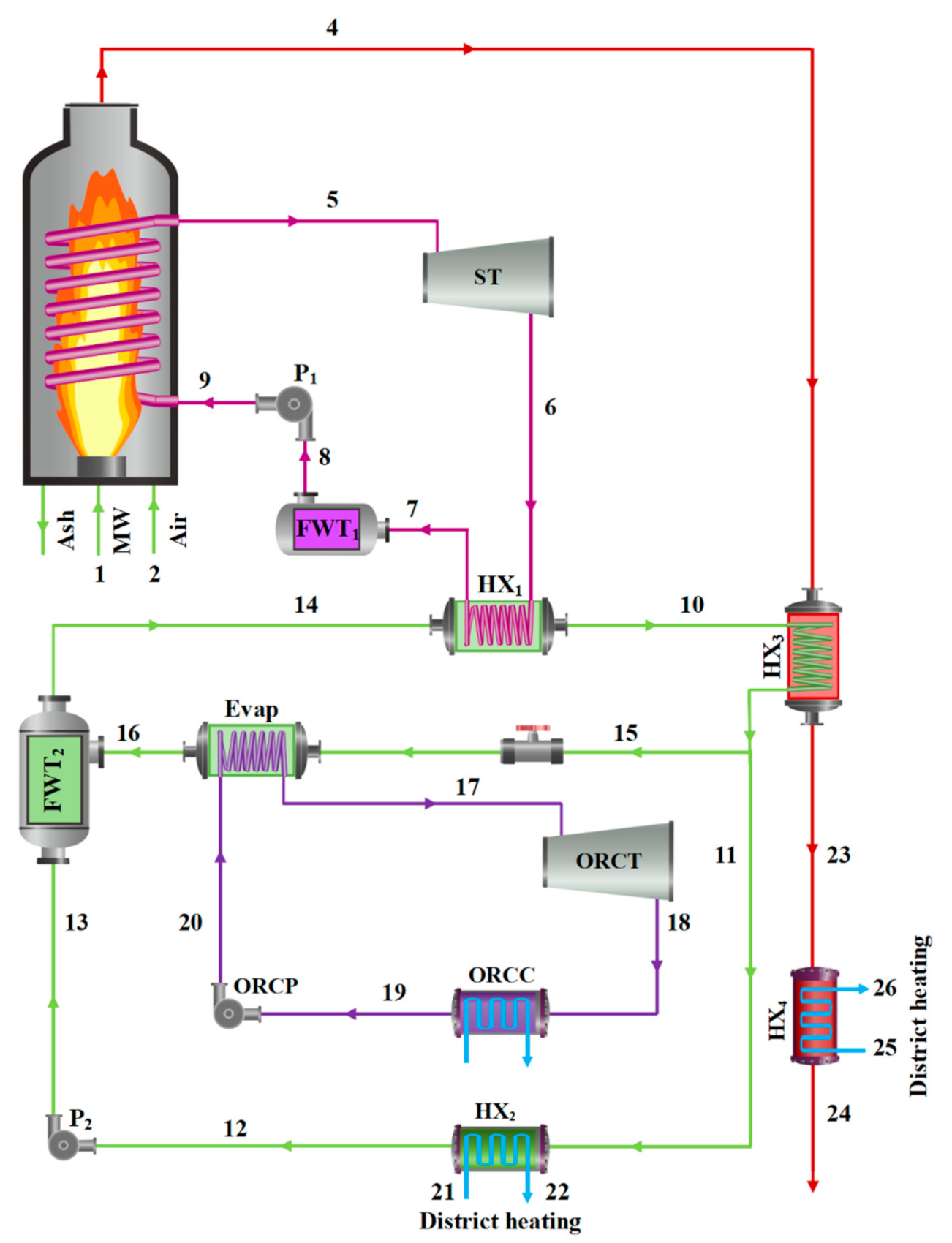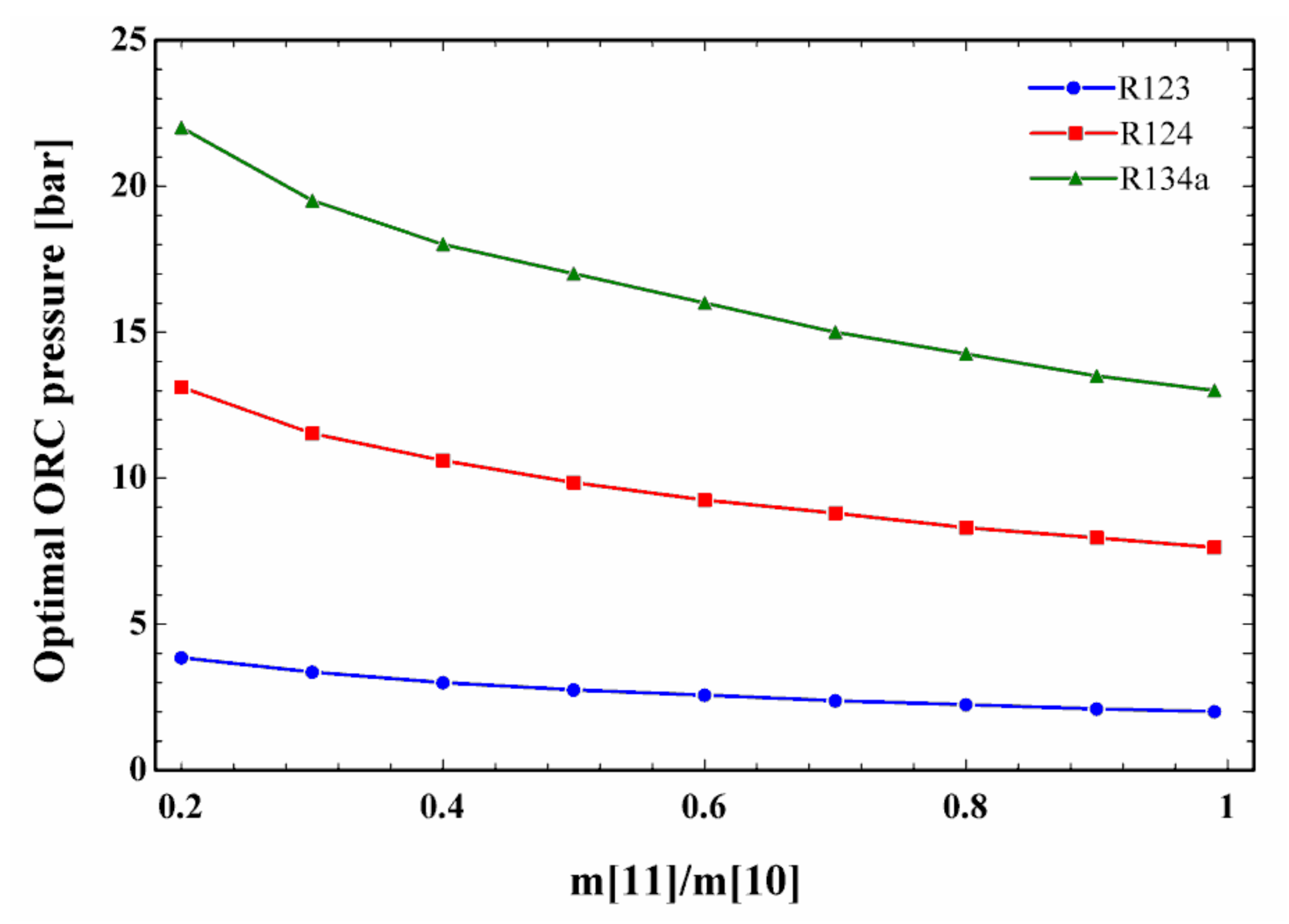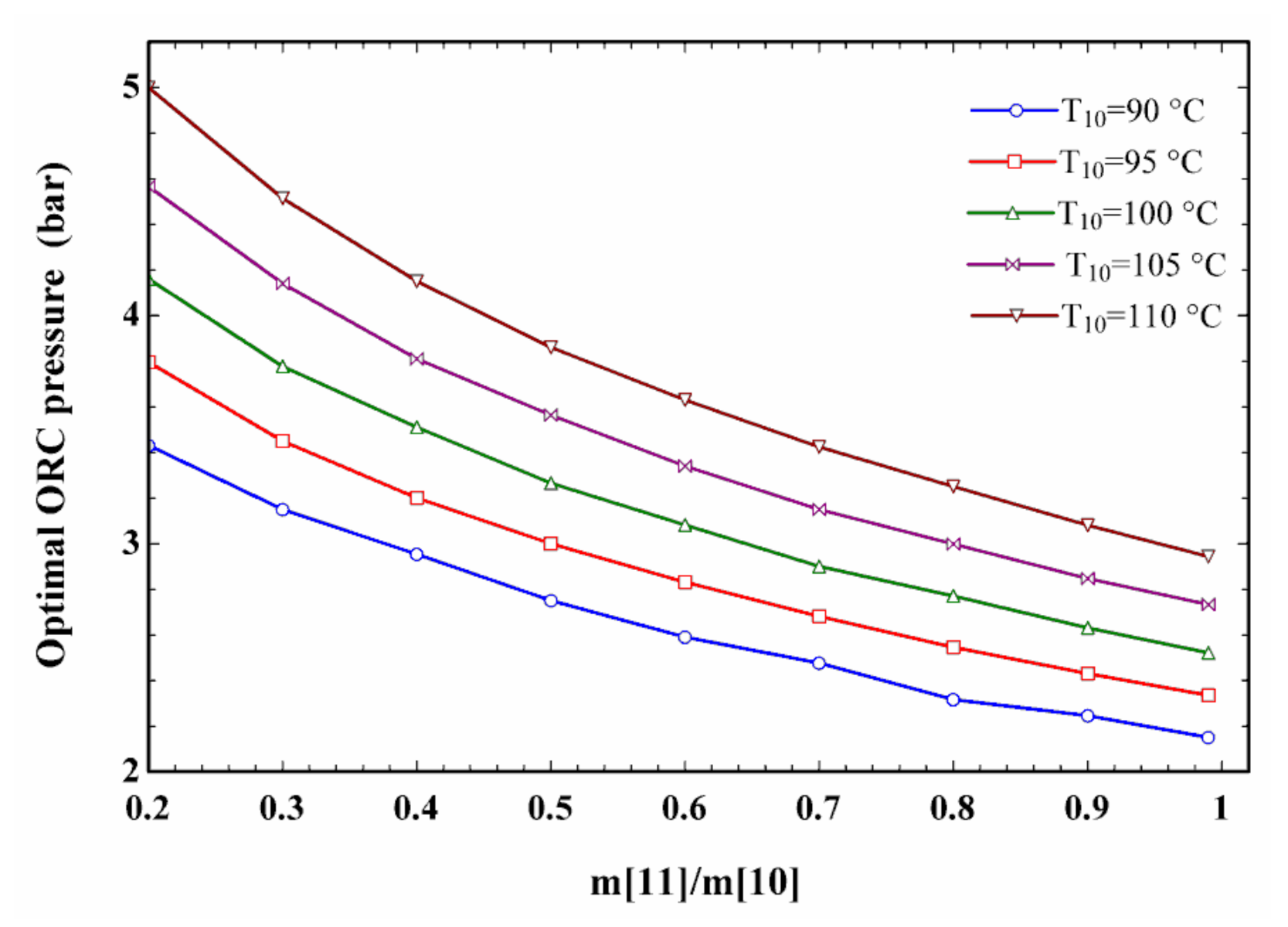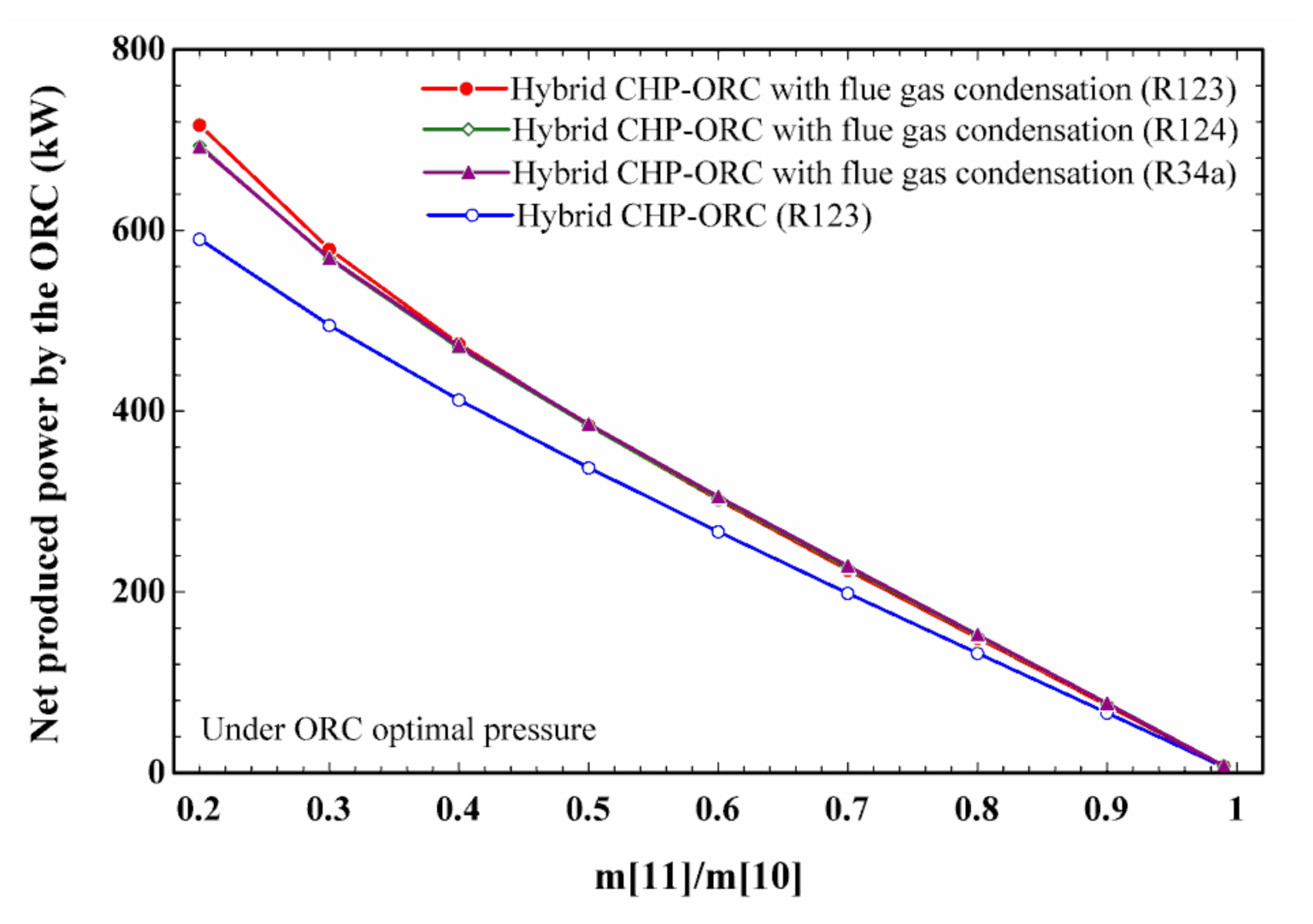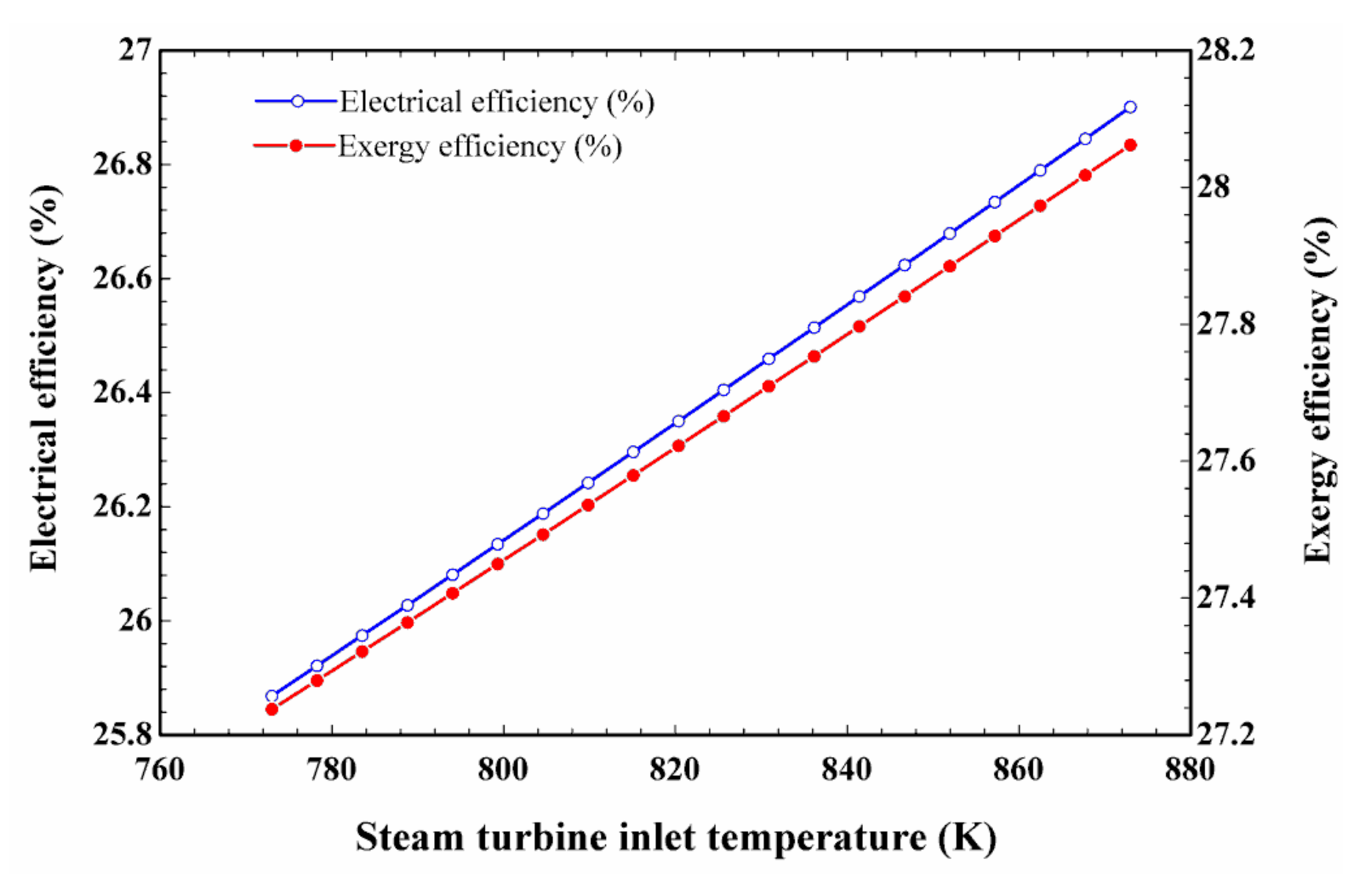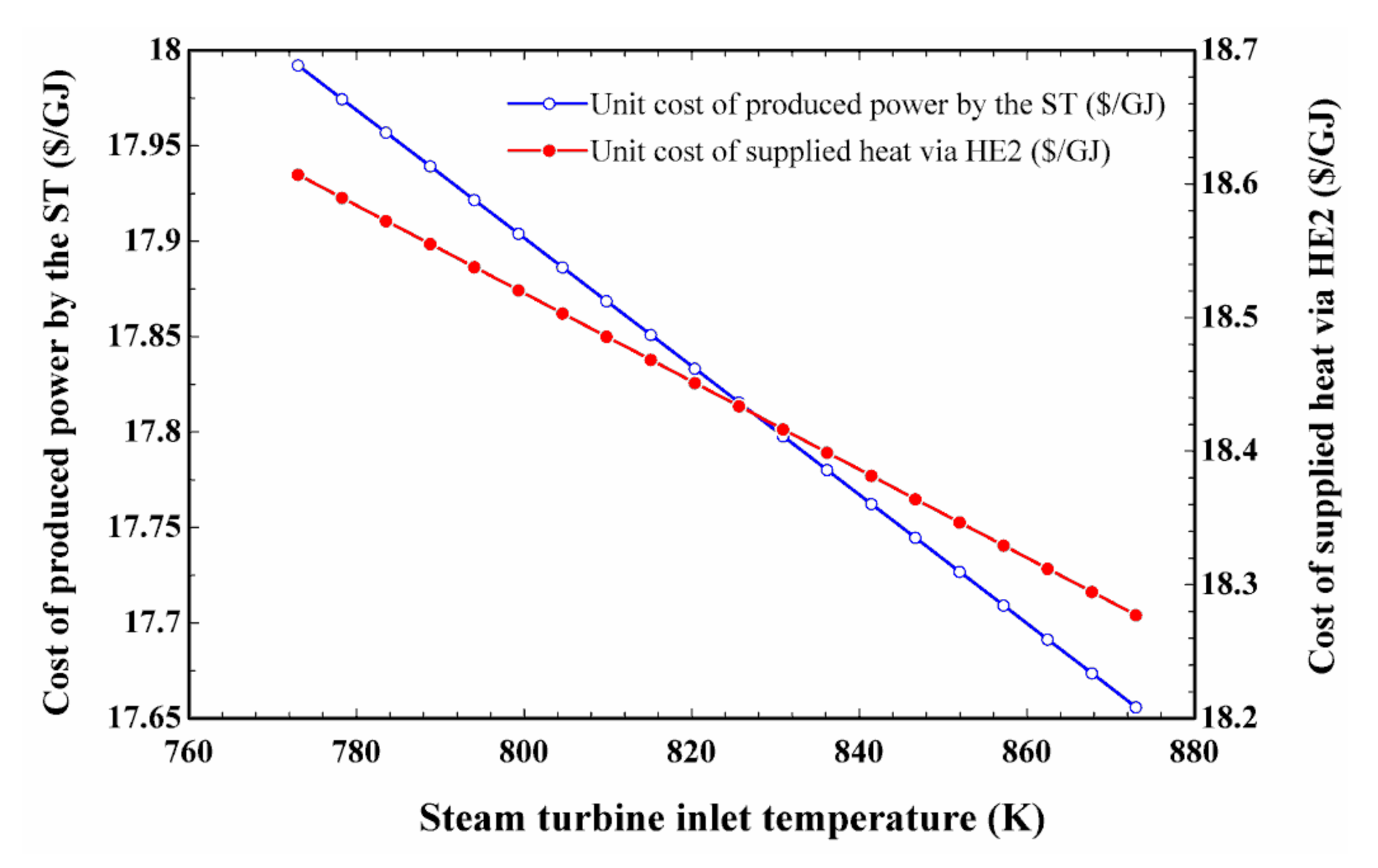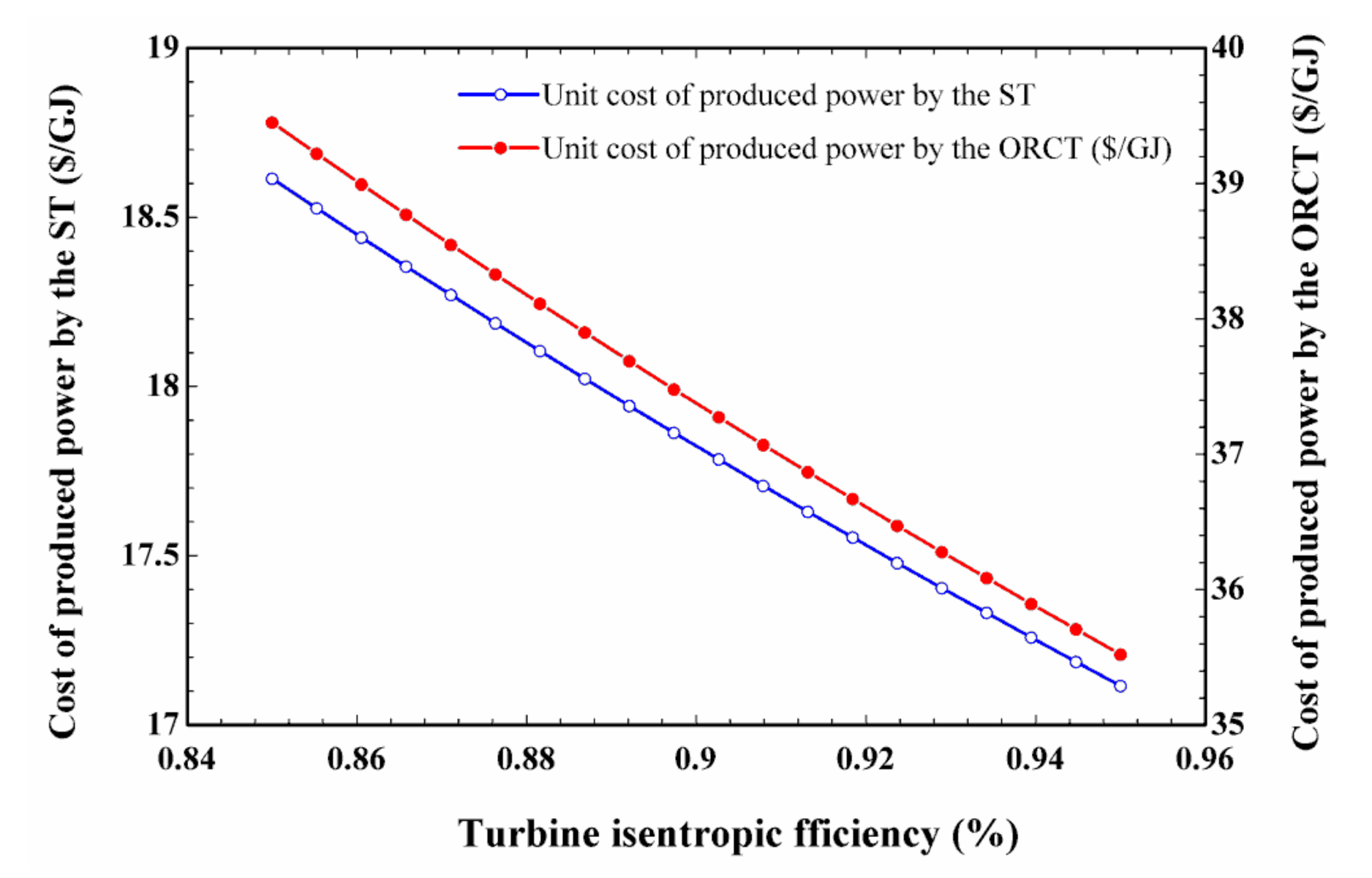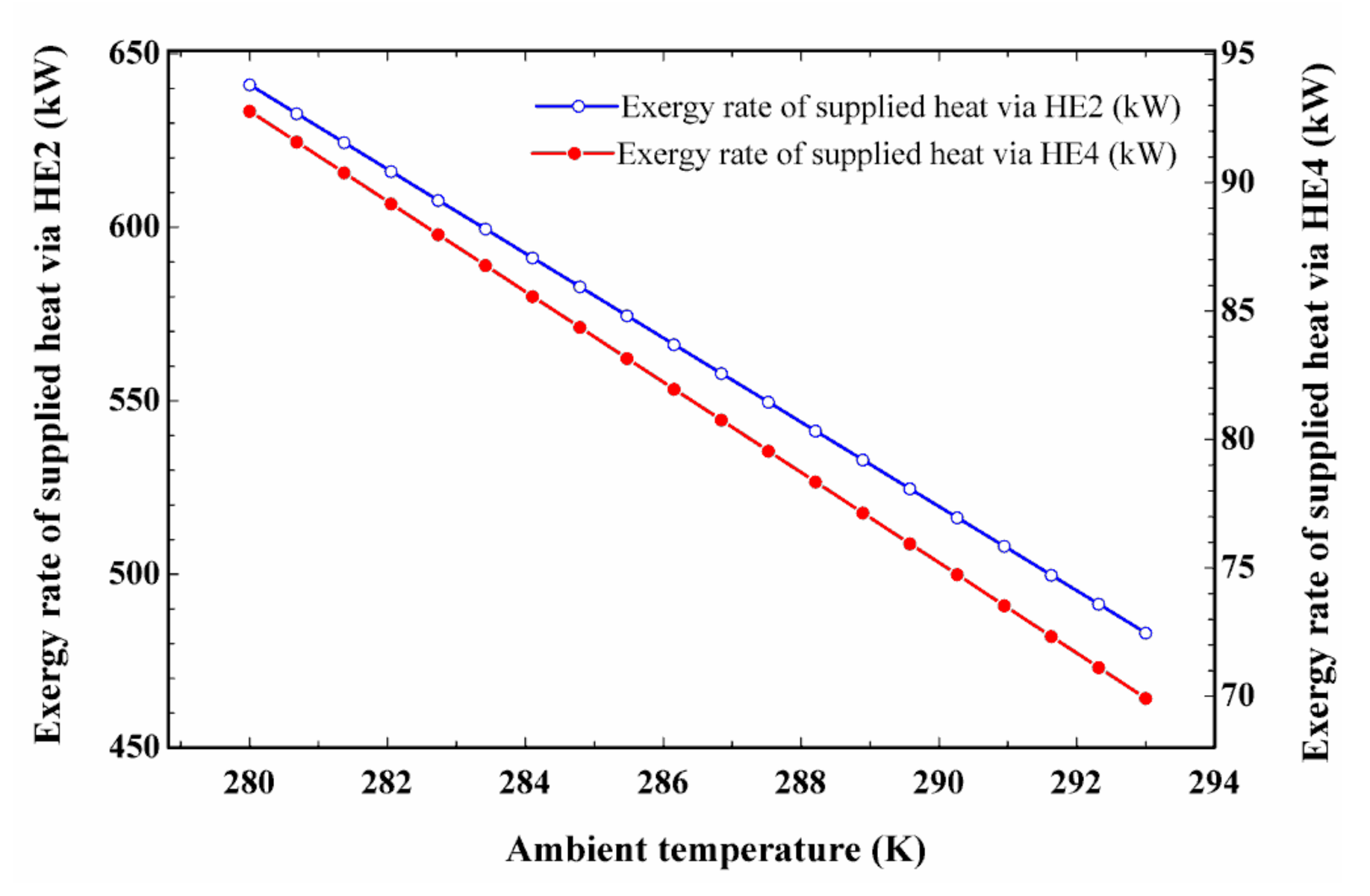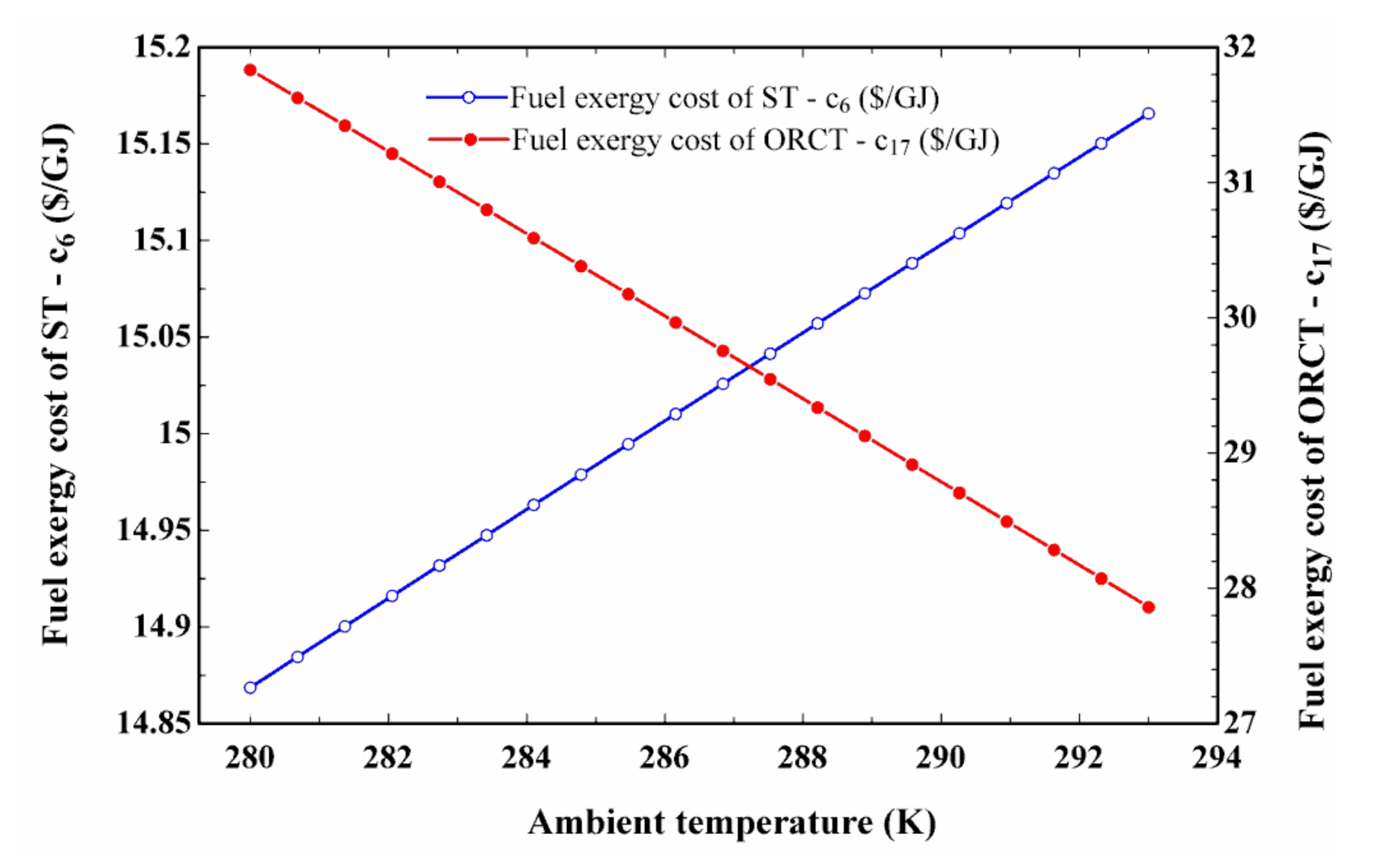1. Introduction
The future smart energy system (which is to be based on a 100% renewable energy share) is said to be more dependent on the electricity sector rather than the heat, cold, and gas sectors. The penetration of the renewable-based power generation systems into energy markets [
1], the increasing growth in the number of electric vehicles [
2]; the increasing penetration of heat pumps and chillers in the district cooling and heating system, etc., are some of the most important reasons for this fact. On the other hand, there are many in-service energy production systems in different sectors that have been installed in recent years and will be working for the next 20–30 years. Therefore, in parallel with the innovations for new-coming technologies, feasible solutions that make existing energy plants compatible with future needs are required.
In Denmark and many other European countries, waste-fired combined heat and power (CHP) plants are considered to be popular and widespread energy systems for the co-generation of heat and electricity for district heating and power grids [
3]. The incineration of CHP plants with flue gas cleaning, producing about three times more heat compared to power, plays a key role in turning waste into energy in an environmentally friendly way. This fact makes such power plants be of high potential for revising the design to increase the share of power output instead of a larger heat generation rate.
The literature presents a substantial number of studies in the field of waste-driven CHPs. For example, Rydén et al. [
4] evaluated the role of hybrid power plants (comprising waste-fired modules) in the future hybrid energy systems in Sweden. Eriksson et al. [
5] scrutinized the operation of the waste incineration co-generation systems in Denmark. Tobiasen and Kamuk [
6] investigated the benefits of employing waste-fired CHP plants in district heating systems, optimizing the efficiency of these systems for larger capacities. Tomić et al. [
7] studied the effectiveness of different waste heat recovery power plants for the recently adopted legislation/regulation in Europe’s energy markets. Munster and Meibom [
8] assessed the best methods for using waste in future energy technologies by proposing novel waste-to-energy plants with maximum efficiency and flexibility. Yang et al. [
9] accomplished a fundamental technoeconomic investigation of a waste-incineration co-generation plant based on a combined intermediary pyrolysis concept. Nami et al. studied the thermodynamic [
10] and economic [
11] performance of a municipal waste-fired tri-generation system to supply the energy demand of the neighborhood in terms of electricity, heating, and cooling.
In the present study, some of the produced heat by the waste-fired CHP system was converted to electrical power by employing an organic Rankine cycle (ORC). Although the organic Rankine cycle (ORC) operates with lower efficiency in comparison to a regular Rankine cycle, the capability of operating at lower pressure and temperature levels makes it an interesting and popular solution mainly for the use of low-quality waste heat sources for power production [
12,
13,
14]. The following four works are a couple of references that give a detailed understanding of the ORC based on the cutting-edge state of the art and practice. Landelle et al. [
15] presented a comprehensive examination of the state of the art of ORC. Hoang [
16] reviewed heat recovery from diesel engines using ORC technology. In this work, he aggregated and classified working fluids to meet the requirement of each system and reported the thermodynamic and economic analyses of engine ORCs. Park et al. [
17] presented a review from the ORC experimental data trends and concluded that the efficiency of heat to power conversion was about 44% of the Carnot cycle efficiency, reporting that R245fa, R123, and R134a are the most popular working fluids, and the typical value for the Back-Work Ratio is around 25.9%. Mahmoudi et al. [
18] presented a new review of waste heat recovery by ORC, including statistics on fluids and configurations, and concluded that internal combustion engines and gas turbines are the most used heat sources. Generally, ORC is a recognized concept with relatively developed technology and literature. Thus, there is no intention of presenting an extensive literature survey of that here.
In the most recent study of the authors, they investigated the parallelization of a small-scale ORC with a waste-fired CHP plant to increase its power output rate [
19]. Although this hybridization resulted in poorer net heat and overall energy output, the higher electricity output of the system made it be a compatible yet feasible solution for future smart energy systems. However, still, the utilization of effluent waste heat via flue gas condensation seems to be a gap in the body of knowledge for waste-driven CHPs. In the present study, the authors tried to present an optimal design of the technology, a thorough exergy assessment, and a comprehensive economic investigation, as well as a reliable environmental analysis. The thermodynamic and economic performance of the developed waste-driven CHP system is compared for the cases with and without flue gas condensation via presenting an improved version of the integrated waste-fired CHP–ORC system.
3. Results and Discussion
The results of the exergoeconomic and exergoenvironmental investigations carried out on the hybrid power plant are herein presented, discussed, and compared with those related to the simple CHP plant and the hybrid CHP–ORC plant without the waste heat recovery loop. For this, first of all, the optimal technical operation of the plant found in [
21] is reviewed quickly.
The optimal values of the ORC higher pressure in different levels of ORC supply rates (m
11/m
10) for various working fluids are shown in
Figure 2. Note that the corresponding pressure to the maximum value of the generated power in the ORC system is determined as its optimal pressure. As can be seen from this figure, the lowest operating pressure belongs to the R123 which can be considered as an advantage for this working fluid from a turbomachinery point of view.
In
Figure 2, the ORC heat source temperature is supposed to be 90 °C. Naturally, the variation in the source temperature affects the obtained optimal pressure values.
Figure 3 illustrates the effect of changing the source temperature of the ORC on the optimal pressure of the cycle. This figure is presented for the working fluid of R123 only because the same trend is observed for the other two working fluids as well. Referring to
Figure 3, increasing the ORC heat source temperature results in higher optimal pressure levels. It should be mentioned that since the ORCT inlet flow is supposed to be in the saturated vapor condition, then a higher source temperature leads to a higher evaporation temperature and higher operating pressure as well.
Table 4 indicates the technical measures related to the first thermodynamic law (energy analysis). One needs this information for accomplishing the aimed analyses. In the proposed design, a share of the high-temperature water in the first heat exchanger goes to the evaporator for running the ORC unit, while the remaining is exploited for heat generation. The ORC unit works based on the optimum evaporator pressure matching with the maximum power output. Recovering the waste heat of the base system increases the performance of the power plant from the perspective of both power and heat generation. In a common power plant, a rise in the exit pressure of the steam turbine is required to support it for providing the needed temperature for the district heating supply. As waste heat recovery can be used for the additional reheating of the pressurized water, the heating of the pressurized water up to the ultimate temperature is not necessary through the CHP condenser, generating more power in the main system. As such, more power is likely to be produced by the ORC unit when the waste heat recovery unit is added to the system resulting from the greater temperature rate of heat supply for the ORC section. Furthermore, around 0.6 MW (megawatt) further supplied heat is delivered as a consequence of recovering a share of the outlet heat (see HX4 in
Figure 1) and an increase for the mass flow rate of the pressurized hot water. In addition, as can be seen, changing the ORC working fluid does not affect the entire system performance considerably. This is because only a small share of power is produced by ORC and the main share refers to the steam turbine.
As presented in
Table 4, applying various organic fluids in the ORC has an insignificant impact on the system’s thermodynamic performance. The same justification can be perceived in
Figure 4, in which quantities of the net generated power in the ORC unit are analyzed and compared for different working fluids and ORC supply rates. Hence, reporting the technical and economic results attained for one of them in the following seems to be reasonable. However, this figure shows the effect of flue gas condensation on the net produced power by the ORC unit which is considered in this study for the first time.
Results associated with the exergoeconomic analysis are reported in detail in
Table 5,
Table 6 and
Table 7 for the conventional CHP plant, the hybrid CHP–ORC system, and the hybrid CHP–ORC with flue gas condensation, respectively. In all of these three cases, it is supposed that the system operates with a capacity of 1 kg/s municipal waste and pressurized hot water temperature of 90 °C providing heat for the local district heating network via HX2. When a small-scale ORC is coupled to the CHP plant (
Table 6 and
Table 7), it is assumed that half of the heated water is applied to drive the ORC and the rest is used to provide the domestic heating.
According to the tables, since an incinerator comes with various origins of irreversibility, i.e., combustion, mixing, temperature difference, etc., [
35], it is responsible for the highest rate of exergy destruction between all components, resulting in the lowest exergetic efficiency as well. Dehghanipour and Ajam [
36] demonstrated that a substantial part of the exergy destruction of a waste incineration power plant happens in the incinerator, the steam generator, and the turbine. This is compatible with the information given in the tables below. As seen, the exergy destruction and exergy efficiency of the incinerator are the same for the simple CHP and hybrid CHP–ORC plants because the incinerator (including the steam generator) operates under the same condition in both systems and employing an ORC unit does not affect its exergetic/energetic performance. In the hybrid system with flue gas condensation, the steam turbine outlet pressure is a bit lower. Therefore, the recycled water to the boiler has a lower temperature and results in a little higher exergy destruction in the incinerator. In addition, the capital cost of the incinerator (including the boiler and pollution control unit) is the highest among all of the components. The levelized cost of USD 231.5/h is the same for the incinerator of all the cases because the incinerator cost is a function of just feeding municipal waste. Furthermore, an exergoeconomic factor of around 76% is obtained for this component. The exergoeconomic factor is applied for comparing the rate of investment cost with the rate of the cost of irreversibility. Thereby, the obtained exergoeconomic factor implies that the capital investment cost of the incinerator is dominant in comparison to the cost rate related to exergy destruction.
Concerning the steam turbine, as
Table 7 represents, exergy destruction in the plant with waste heat recovery is greater than that reported for the other two cases. As mentioned before, a decrease in the steam turbine exit pressure is implemented and thereby both the produced power and destroyed exergy increase in this way. Compared with the incinerator, the steam turbine has a lower exergoeconomic factor, indicating that the cost of exergy destruction in this component has a significant effect so that an enhancement in the exergetic performance of the turbine increases the whole system economic index.
The lowest exergoeconomic factor in the simple CHP plant belongs to the HX1 followed by HX2 with the exergy destruction rates of, respectively, 384 and 138.9 kW, showing that the cost of irreversibility in these components has more effect than the investment cost on their economic performance. In fact, the exergy destruction of these components is mainly because of the temperature difference among the hot and cold streams, indicating the need for paying great attention to these components. When the ORC unit is added to improve the share of electricity production, the lowest exergoeconomic factor is for the ORC evaporator. The exergoeconomic factor of around 2.4% and the second law efficiency of around 73% show that much can be done to improve the evaporator exergetic, and consequently, economic performances. One can say that almost all the cost of Evap that has been imposed on the system is due to the exergy destruction within this component. It seems that the organic working fluid evaporation and the temperature mismatching between the hot and cold streams are the main reasons for the irreversibility in this component.
Reconsidering the tables, one finds the highest exergoeconomic factor for the pump employed in the steam cycle. In this way, replacing the pump with a cheaper one can be suggested to cure the system’s economic performance. However, it is necessary to mention that the recommendations made for improving the economic performance of each component utilized in the systems do not necessarily mean an improvement in the whole system performance. This is since the performance of the other equipment can be reduced by changing the operational condition or characteristics of the others.
Overall, regarding the whole system, the exergy destruction in the plant with flue gas condensation is the lowest. Note that the exergy flow discharged to the atmosphere by the effluent is considered as an exergy loss flow when calculating the total exergy destruction rate of the plants. Moreover, as it is proven in Ref. [
21], for the case of a hybrid CHP–ORC plant, when the ORC supply rate is half of the heated water, the exergy efficiency will hit its minimum value. This is why the exergy efficiency of the simple CHP plant is higher than that of the hybrid cycle.
Table 8 outlines the exergy rates, unit exergy cost, and levelized costs of different states in the plant with flue gas condensation. As listed, the unit cost of produced power by the steam turbine is USD 17.82/GJ which is comparable with that reported in the exergoeconomic analysis of a municipal waste-to-energy steam reheat power plant for Port Harcourt city [
22]. Additionally, the cost of extra electricity produced by the ORC is much higher than that produced by the steam turbine. The average unit cost of supplied fuel for the individual component is the main reason for this. As reported in
Table 8, the unit cost of supplied fuel for the ORC turbine (c
17) is USD 30.88/GJ, while it takes the value of USD 14.94/GJ for the case of the steam turbine (c
6). Referring to this table, and the results associated with energy analysis, the average unit cost of the electricity and heat produced by the proposed CHP are USD 20.07/GJ and USD 17.96/GJ, respectively.
The results associated with the environmental impact of the plants are presented in
Table 9. As can be seen, the level of pollution is equivalent to a cost of USD 210.7 for the systems. Since in all three scenarios, the systems are operating with a capacity of 1 kg/s MW, the released pollution (available in the effluent) and their equivalent costs are the same. Therefore, the sustainability index and the CO
2-e per produced exergy are considered to show a bigger picture of the environmental impact of each system. As seen, the highest SI refers to the plant with flue gas condensation due to recovering the available exergy in the effluent and produce more exergy compared with the other two plants. The lowest SI belongs to the hybrid CHP–ORC plant, which is mainly because improving the power share via employing the ORC decreases the supplied heat and subsequently, the exergy rate related to the exchanged heat. However, it should not be neglected that enhancing the power share of the power plant energy output via adding an ORC unit is a valuable benefit that this case is also offering compared to the conventional waste-fired CHP plant.
As mentioned before, in the present research, an average emission of 0.415 kg of CO
2-e for the incineration of 1 kg of MW is considered. To show the effect of modifying the system configuration, this parameter is divided into the total produced exergy by each system (
) and listed in
Table 9. As expected, the hybrid CHP–ORC plant has the highest equivalent CO
2 emission, while the plant with flue gas condensation has the lowest one.
The results of a sensitivity analysis carried out on the thermodynamic and economic performance of the system versus various important parameters are presented and discussed hereunder. Here, the results are only related to the waste-driven hybrid CHP–ORC with flue gas condensation. For this sensitivity analysis, it was assumed that all the other parameters were fixed as the effect of changing the value of a certain parameter was assessed.
Figure 5 shows how the electrical and exergy efficiencies of the plant vary as the steam turbine inlet temperature rises. As seen, this has a direct effect on both of these parameters in an almost linear format so that when the steam turbine inlet temperature increases from 773 to 873 K (500–600 °C), the electrical and exergy efficiencies change from 25.87% to 26.9% and from 27.24% to 28.06%, respectively. In this study, however, the turbine inlet temperature of 550 °C is considered in the system modeling due to technical limitations.
Observations confirm that growing the turbine inlet temperature in the same range as above decreases the cost of generated power in the steam turbine from USD 17.99/GJ to USD 17.66/GJ and decreases the cost of supplied heat via HX2 from USD 18.61/GJ to USD 18.28/GJ. This is shown in
Figure 6.
Figure 7 illustrates how the isentropic efficiency of the turbines affects the cost of power production in the system. As shown, a reduction in the cost of produced power is achieved when the isentropic efficiency of the turbines increases. In fact, the figure reveals that although increasing the turbine isentropic efficiency leads to higher values of capital investment cost, the effect of the enhancement in the amount of output electricity is stronger economically. According to the figure, increasing the isentropic efficiency from 0.85 to 0.95 results in USD 0.33/GJ and USD 0.59/GJ drop in the cost of produced power for the ST and ORCT, respectively. Isentropic efficiency of 0.9 and 0.85 is supposed for ST and ORCT in the system modeling, respectively.
The impact of the ambient temperature on the system performance is examined in
Figure 8,
Figure 9 and
Figure 10. According to
Figure 8, the ambient temperature growth reduces the exergy efficiency of the system. As the main part of the district heating supply in the system is via HX2, the cost of heat supply via this heat exchanger is evaluated. According to the figure, an increase in the ambient temperature causes a higher value of heat supply cost. This is mainly due to a reduction in the rate of delivered thermal exergy, while the initial capital cost of equipment is fixed. As such, it can be read from the figure that increasing the ambient temperature causes an increment in the cost of steam turbine power, while it decreases the cost of ORCT power. The net output power and exergy rate of the incinerated municipal waste are independent of the ambient temperature and decreasing the exergy rate associated with the lower supplied heat is the main reason for the exergy efficiency reduction.
As seen in
Figure 9, as the weather becomes warmer, the rate of exergy supplied via the HX2 and HX4 decreases almost linearly.
Figure 10 investigates the fuel exergy cost of the ST and the ORCT versus the ambient temperature. As seen, growing the ambient temperature rises the fuel exergy cost of ST and reduces the fuel exergy cost of the ORCT.
Figure 11 specifies the alteration in the cost of generating electricity by changing the unit cost of MW. As shown, increasing the unit cost of MW results in a linear growth in the cost of electricity generation via both ORCT and ST. MW is the input fuel for the whole system and a higher value for its cost will raise the cost of products. When the unit cost of MW changes from USD 1.5/GJ to USD 2.5/GJ, the cost of produced power by the ST and ORCT increases from USD 16.57/GJ to USD 19.08/GJ and from USD 34.78/GJ to USD 39.97/GJ, correspondingly. The unit cost of MW is considered to be USD 2/MJ in the modeling of this work, as stated by Jack et al. [
22].
